In 1954 Paul Taylor formed the Paul Taylor Dance Company in New York City; today the 77-year-old Taylor continues to produce choreography for his two companies in the characteristic gymnastic cross between ballet and modern dance that is a hallmark of his own varied dance career—he danced for George Balanchine’s New York City Ballet as well as for Merce Cunningham’s and Martha Graham’s companies.
His remarks on his choreography reveal a potent mix of compulsion and artistic commitment: “I make dances because I can’t help it. Working on dances has become a way of life, an addiction that at times resembles a fatal disease. Even so, I’ve no intention of kicking the habit. I make dances because I believe in the power of contemporary dance, its immediacy, its potency, its universality.”
Dance, however, takes an abstract, though narrative, bent in Taylor’s efforts to live in the world: “A visual medium can be more effective than words. I make dances because I don’t always trust my own words.”
This past weekend San Francisco Bay Area audiences got a chance to see Taylor’s own brand of cri de coeur, when the company presented three programs out of Taylor’s vast repertoire at Yerba Buena’s Novellus Theater as part of San Francisco Performance’s rich concert programming.
The program opened with Mercuric Tidings, an abstract blend of dance set to excerpts from Schubert’s First and Second Symphonies. Clad in ultramarine unitards with magenta lines looping around the body, the company went through its rapid and demanding formations, the steps primarily taken from ballet but reduced to the gestural in order to speed the movement. The choreography showcased the company’s unfailing athleticism and energy.
Scudorama, a piece first performed in 1963, strove to examine darker human emotions. In front of an Alex Katz–designed backdrop of black clouds filling a mauve-to-magenta twilight sky, a dancer in a ‘50s suit with skinny woven tie rises above unitard-clad dancers who crawl and writhe across the stage.
A hunched figure draped with a bright patchwork bath-towel blanket scutters across the floor, one whimsical yet ominous presence coiled around another dancer. To a jazzy composition by Clarence Jackson, the dancers enact scenes of a contemporary urban hell. The program notes use a quotation from Dante’s Inferno as an epigraph to the piece: “ ‘What souls are these who run through this black haze?’/And he to me: ‘These are the nearly soulless/Whose lives concluded neither blame nor praise.’”
It’s the defiant criticism by a young artist of an indifferent and self-absorbed culture.
Taylor’s more recent work, the 2008 Beloved Renegade, takes a more philosophical, even metaphysical, look at the same outsider mentality. A corps of dancers surround and interact with two figures whose presence and relationship on the stage seem to represent a form of idealized love—he dressed in white blouse and pants and danced by Michael Trusnovec; she, danced by Laura Halzak, in camisole-topped white unitard. At times the two unite with the corps, even while remaining aloof. Their stately pas de deux suggests a numinous and romanticized connection, like that between poet and muse. Fragments from Walt Whitman’s sensual celebration of the body and life, Leaves of Grass, entitle each section, but the music is Poulenc’s Gloria, the six-part setting of the Roman Catholic Gloria in Excelsis Deo text. What could more accurately describe the dancer’s vocation than such a mixture of celebrations—one centered on joy in the body, the other exulting in the presence of the divine?
—Jaime Robles
Originally published in the Piedmont Post
